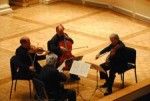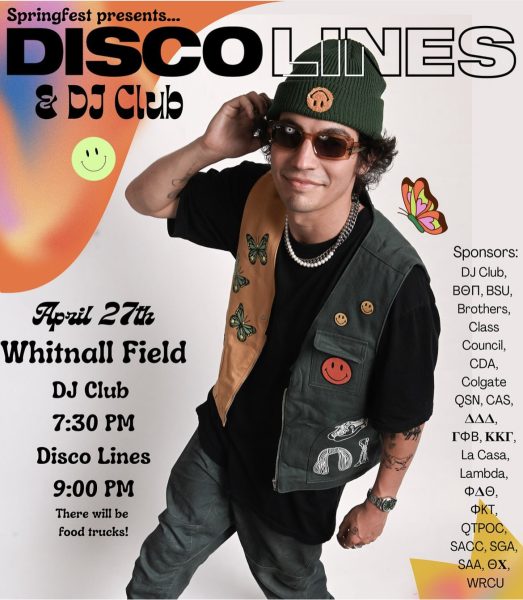Manhattan String Quartet Returns

The Manhattan String Quartet culminated their stay at Colgate last Friday, October 26 with a performance of three 19th century pieces by the late composer Ludwig Van Beethoven. Hamilton residents and Colgate students and faculty gathered at 7:30 p.m. to hear violinists Eric Lewis and Calvin Wiersma, viola player John Dexter, and cellist Chris Finckel fill the Chapel with the sounds of “String Quartet in A Major, Op.18, No. 5,” “String Quartet in E Flat Major, Op. 127” and “String Quartet in E. minor, Op.59, No. 2.”
Sponsored by the Core program and funded in part by the New York State Council for the Arts, the Manhattan String Quartet (MSQ) has been in residence at Colgate for 22 years. They visit campus in the fall and spring for three days at a time, during which they teach classes covering the musical component of the Core 152 curriculum, present a lecture on a piece of music written near the turn of the 20th century, and perform a final concert for the Colgate and Hamilton communities. This year’s lecture took place on Thursday, October 25 and was centered on a piece by Claude Debussy, whose music is considered more modern than that of Beethoven.
“We always look forward to coming back to Colgate,” viola player John Dexter said. “The Core program is a perfect fit for what we are able to do, and the students are really receptive.”
Hailed as one of America’s leading chamber ensembles, The Manhattan String Quartet has toured and performed at various locations throughout the U.S, Canada, Europe and Mexico, including Lincoln Center in New York City and the Sylvia and Danny Kaye playhouse in Paris. They have also appeared on French National Radio. They hold similar In Residence posts at musical and educational institutions and festivals nationwide and have recorded a number of works in vinyl and compact disc.
At Friday night’s performance the audience was provided with programs containing this information about the MSQ, as well as the names of the three pieces to be played and notes concerning their history, themes and content.
The MSQ began with the 20 minute “String Quartet in A Major, Op. 18, No. 5,” which, written in 1800, was the earliest of the evening’s three quartets. As with the pieces that followed, it was divided into four distinct movements. The piece opened with a Classical, fast-paced Allegro, and then moved into a lyrical and similarly fast-paced Menuetto. The third Andante cantabile movement was long and full of rhythm and sound variation, and the piece concluded with an Allegro resembling the opening of Beethoven’s fifth symphony.
The second piece, “String Quartet in E Flat Major, Op.127,” was written in 1827, and according to the MSQ, was really a 20th century quartet. It lasted around 30 minutes. The first movement combined Maestoso with a simple and lyric Allegro and the lengthy second movement continued with five thematic variations. The galloping rhythm, plucking, and interruptions of the third movement contrasted the lyrical unity of the first two, and the fourth movement brought in a fast pace and liveliness to end the piece in a tour de force of rhythm and sound.
After a brief intermission, the MSQ returned to play their final piece. “String Quartet in E minor, Op. 59, No. 2” was written in 1807 and also lasted around 30 minutes. The first movement was a stark Allegro, and according to Finckel, the second an “epic lament of more than twelve minutes.” The piece continued with a rhythmic Allegretto and ended with a “boisterous” Presto and as Finckel wrote in the program notes, a “fervid, frenzied coda.”
“I felt like I had played 10 rounds after the concert was over,” Finckel said. “The pieces are very difficult and complex. Beethoven could take a tiny idea and build an entire piece around it.”
The Manhattan String Quarter received widespread applause from the audience after the culmination of each piece, as well as a standing ovation during their final bow.
Hill, who is a Music major, said she attended the performance because she is currently taking a music history class covering Beethoven symphonies.
“These romantic pieces really relate to what we are studying,” Hill said. “The first sounds classical, but it plays with audience’s expectations by continually stopping and starting up again. Then, the later pieces take off in an entirely different direction and turn these expectations around.”
A reception took place in the Chapel’s basement following the show, during which audience members were able to converse with the musicians and enjoy refreshments.
Dexter said he hoped the music had an effect on all audience members.
“Even if you don’t know anything about music, you can follow Beethoven’s train of thought through the slow movements,” Dexter said. “You just have to let the music flow over you.”







